Femia > Health Library > Your cycle > Health > Understanding the ovulation phase: Symptoms, foods to eat, and how it affects mood
Understanding the ovulation phase: Symptoms, foods to eat, and how it affects mood
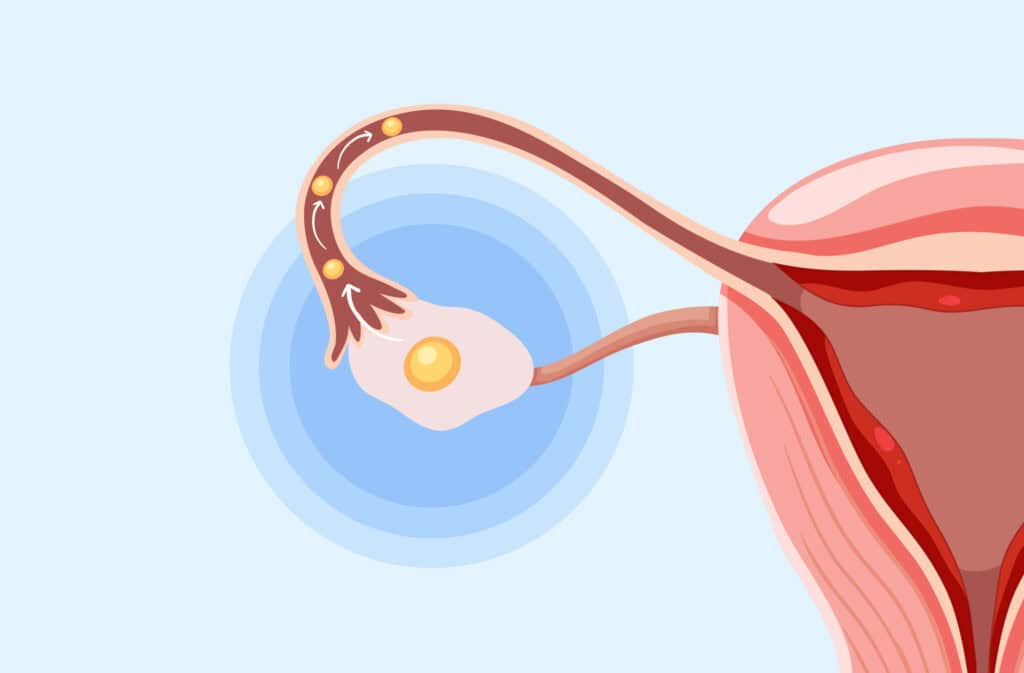
- Updated Feb 11, 2025
- Published
CRAFTED BY HUMAN
Crafted by human At Femia, we provide accurate and up-to-date information at every stage of your journey, from trying to conceive, pregnancy and postnatal support. All content is created by a real person based on in-depth research and own professional experience. Femia ensures that you will receive expert advice, strict accuracy and a personalized approach from our authors/medical experts. Learn more about our editorial policy.
FACT CHECKED
Fact checked At Femia Health, we maintain the highest standards of editorial excellence in delivering content focused on helping you conceive, guiding you through pregnancy, and supporting you postpartum. Explore our content review principles to learn how we ensure the accuracy and quality of our health and lifestyle tips for every stage of your journey.
The ovulation phase is a part of your menstrual cycle that typically occurs in its middle- around day 14 in a 28-day cycle. During this phase, your luteinizing hormone (LH) levels surge causing an egg to mature and get released from the follicle, causing the peak of your fertility and the following common symptoms:
- Breast tenderness
- Bloating
- Changes in the position and firmness of your cervix
- Increased libido
- Heightened senses (e.g. smell, sight, or taste)
- Changes in appetite
- Mood swings
Though these symptoms often don’t need to be addressed, supplementing your diet with ovulation phase foods like leafy greens, berries, antioxidant-rich fruits, lean proteins, and healthy fats can help you support fertility and conception.
The ovulation phase is one of the four stages of your menstrual cycle that follows right after the follicular phase and marks the start of the second half of your cycle. Ovulation plays a special role in the female reproductive system. It’s the most fertile time of the cycle – when your body releases a mature egg that can be fertilized by the male sperm cells.
Understanding your ovulation phase is important for ensuring or preventing pregnancy, as well as for providing comfort and well-being during this time. In this article, we’ll tell you about the ovulation phase symptoms, and the foods that can help you support your fertility, and we’ll share other ovulation tips.
Femia offers personalized insights on ovulation, hyperovulation,
and conception chances
What is the ovulation phase?
The ovulation is a short phase marking the second half of your menstrual cycle – when your ovary releases a mature egg (ovum) to be fertilized. Typically, it occurs right in the middle of your cycle. After the egg is released from the follicle, it starts traveling down your fallopian tube to reach the uterus.
On the hormonal level, ovulation is triggered by the two pituitary gland hormones–the follicle-stimulating hormone and the luteinizing hormone (LH). When the level of estrogen (which is predominant in your body during the first half of your cycle) peaks, it produces a sudden surge of LH, right before ovulation. The peaking LH levels during the ovulation phase cause the final egg maturation and follicular collapse for its release.
When is the ovulation phase?
In a typical 28-day menstrual cycle, the ovulation phase typically takes place on the 14th day. However, its start can vary depending on your cycle’s length and other individual factors.
There are a few ways to track the start of ovulation:
- Use an ovulation predictor kit. These kits track the LH levels in your body. LH surges 28 to 36 hours before ovulation and peaks 10 to 12 hours before it.
- Track your basal body temperature. For most people, the typical basal temperature before ovulation is around 96 to 98 F (35.5 to 36.6 C). After ovulation, it goes up to 97 to 99 F (36.1 to 37.2 C).
- Pay attention to your symptoms. Typically, ovulation is accompanied by a number of physical and mental symptoms, including increased libido, elevated mood, and others. Paying attention to these symptoms can also help you track the start of your ovulation.
- Extra tip: To streamline the process and increase accuracy, you can also consider using cycle or fertility tracking solutions to predict your ovulation.
👉Find out more: Hyperovulation: You can ovulate twice in a month?
How long is ovulation?
From the moment it’s released, the egg typically remains fertile for about 12-24 hours. So that’s how long the ovulation lasts. However, the time leading up to ovulation (also called the fertile window) lasts for around 5-6 days: 5 days before ovulation and includes the first day after ovulation. Throughout all this time you are fertile and it’s possible to conceive a child, which is why tracking your fertile window is also crucial, whether you are planning a pregnancy or want to avoid it.
Ovulation phase symptoms: What to expect
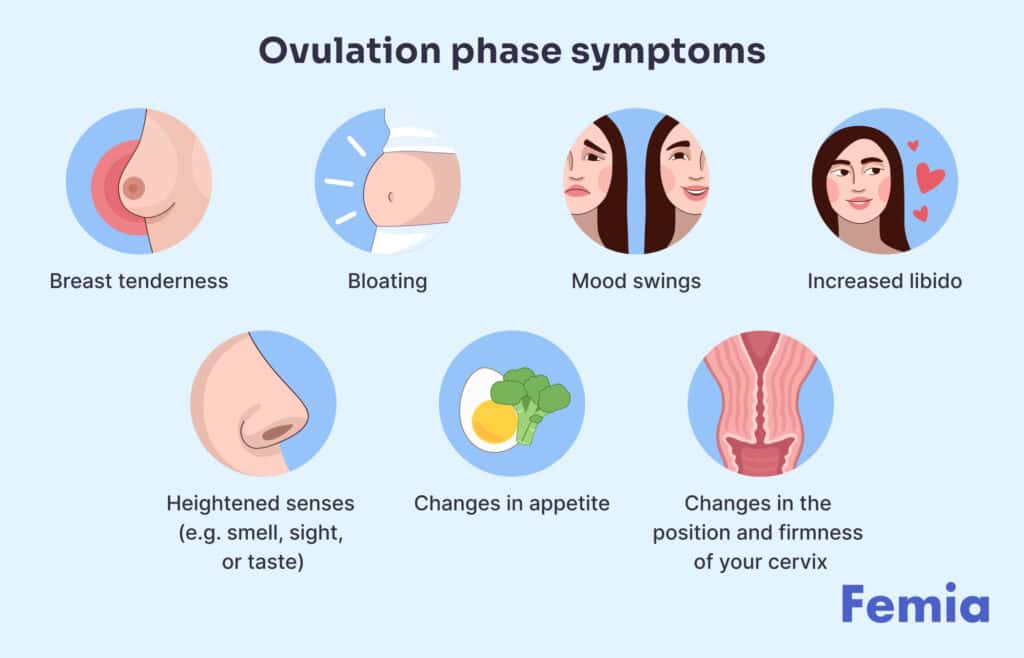
The changing hormone dominance often causes a number of physical and mental symptoms during the ovulation phase. The most common ones include:
- Breast tenderness
- Bloating
- Changes in the position and firmness of your cervix
- Increased libido
- Heightened senses (e.g. smell, sight, or taste)
- Changes in appetite
- Mood swings
Additionally, some females may experience mild cramping in the pelvic or abdominal area, as well as light bleeding or spotting. These symptoms are considered normal during ovulation, albeit they might seem somewhat disturbing. Light cramping and spotting might be caused by the changing levels of estrogen or follicle rupture. In most cases, it’s not a sign of a problem.
Ovulation discharge changes
Vaginal discharge is one of the primary signals of changes inside your body. Changing hormones during the ovulation phase also causes changes in your cervical mucus. When ovulation approaches, your discharge will typically become clear, stretchy, and slippery, resembling raw egg whites. Such mucus signals the peak of your fertility because its wet and slippery consistency is meant to make it easier for sperm to swim and meet a mature egg to fertilize it.
Ovulation phase mood: How hormones affect emotions
Right before the ovulation, the levels of estrogen peak in your body, whereas the levels of progesterone are at their lowest. High estrogen is linked to a variety of benefits, including:
- Maintaining cardiovascular tissue health
- Improving muscle mass and bone density
- Protecting your brain by maintaining proper blood flow
It’s also associated with mental benefits. Namely, many females report having a more elevated ovulation phase mood. Higher progesterone can boost energy and increase confidence. Some women may feel more social and outgoing during this time, and many females may experience increased sex drive and heightened pleasure.
@femia.fertility How do you track your ovulation? Where do you store the test results to track the progression of the result line? Share your experience in the comments! #ovulationtest #ovulation #lhtest #fertilitytracker #fertility #ttccommunity #ttcjourney #fertilityjourney #opk ♬ original sound - Femia fertility app
What to eat during ovulation phase: Supporting fertility
If you are trying to conceive, it could be helpful to complement your diet with special ovulation phase foods to ensure optimal hormone function and support fertility.
Leafy greens
Leafy greens, such as kale, spinach, and others, are known for their high fiber content, along with added magnesium, iron, calcium, and potassium. This combination of nutrients helps regulate hormones and ensure overall better health. Also, leafy greens are rich in folic acid, which is one of the core supplements to take before and during pregnancy.
Berries and antioxidant-rich fruits
Blueberries, cranberries, red grapes, peaches, strawberries, raspberries, cherries, and some other berries and fruits are known as natural antioxidants and anti-inflammatory phytonutrients. They support your health with magnesium, potassium, prebiotics, fiber, and vitamins C and K. And some berries are also rich in folic acid. Also, citrus fruits, rich in vitamin C, can help support ovulation and egg health.
Lean proteins
Lean proteins – like eggs, chicken, fish – play a pivotal role in regulating your cycle and producing hormones. They help support egg health, conception, and implantation, which makes them a perfect food for ovulation.
Healthy fats
Healthy fats sources from avocados, nuts, and seeds support your body with zinc and fat-soluble vitamins A, D, E, and K. These support hormonal levels, boost egg quality, and reduce inflammation.
👉Find out more: Cycle syncing diet: What to eat during each phase of your menstrual cycle
Sex during ovulation: Timing and libido
Peaking estrogen during your fertile window and ovulation can significantly increase your sex drive. Being in your most fertile state, your body will be the most prepared for sex during this time. Apart from stimulating your libido, estrogen will also ensure the proper level of lubrication and elasticity of your vagina, helping you have more comfortable and enjoyable sex.
Thanks to high fertility and increased libido, the ovulation phase is the ideal time for conception. If you’re trying to conceive you can try the timed intercourse method, which involves calculating the time of your fertile window and ovulation to have sex during the time with the highest likelihood of getting pregnant. Consider using fertility trackers, monitoring your symptoms, and leveraging ovulation tests to understand your ideal fertility time better and make the most out of your ovulation.
Femia offers personalized insights on ovulation, hyperovulation,
and conception chances
Questions from the Femia community
Can I feel ovulation happening?
Yes, some women can physically feel when their ovulation occurs. They experience mild cramping, known as mittelschmerz, which occurs during the follicle rupture as the egg is released.
How accurate are ovulation predictor kits?
According to the U.S. Food and Drug Administration (FDA), these kits are around 90% accurate. They are used to detect the surge in luteinizing hormone (LH) that takes place right before ovulation.
What if I don’t notice any changes in ovulation discharge?
Ovulation discharge is typically seen as clear and stretchy, similar to an egg white, though it’s not unusual for some women to not notice any tangible changes in their mucus. If you don’t notice changes in your discharge, it doesn’t necessarily mean that you are not ovulating. Consider tracking your cycle and symptoms or using ovulation predictor kits to know when you ovulate for sure.
How can I track my ovulation phase?
To accurately track your ovulation phase, using an ovulation tracking app can be incredibly helpful. These apps analyze your cycle data, predict ovulation days, and alert you to key fertility windows. By identifying this phase, you can better manage symptoms like bloating, mood swings, and increased appetite.
The bottom line
The ovulation phase takes place somewhere in the middle of your cycle and marks the start of its second half. In a 28-day cycle, ovulation occurs around day 14, when follicles collapse under the surge of luteinizing hormone and release a mature egg that can be fertilized for around 12-24 hours.
Ovulation closes your fertile window and is an ideal time for conception. The rise in estrogen and luteinizing hormones can stimulate your sex drive, elevate your mood, and make you more confident, creating the right settings for conception. Additionally, the ovulation phase can be accompanied by such symptoms as:
- Breast tenderness
- Bloating
- Changes in the position and firmness of your cervix
- Heightened senses (e.g. smell, sight, or taste)
- Changes in appetite
Understanding your ovulation timing is important whether you’re planning a baby or not. Tracking your cycle and seeing the symptoms can help you ensure successful conception or, on the contrary, prevent unwanted pregnancy. If you’re trying to conceive, consider supplementing your diet with the ovulation phase foods mentioned in this article and leveraging the timed intercourse method to boost your chances of pregnancy.
References
- “Ovulation.” Cleveland Clinic, 8 Jul. 2022, https://my.clevelandclinic.org/health/articles/23439-ovulation.
- “The Menstrual Cycle.” UCSF Health, https://www.ucsfhealth.org/education/the-menstrual-cycle#:~:text=starved%22%20of%20FSH.-,Ovulation,follicular%20collapse%20with%20egg%20extrusion.
- “Basal Body Temperature.” Cleveland Clinic, 19 Dec. 2022, https://my.clevelandclinic.org/health/articles/21065-basal-body-temperature.
- “Conception: How It Works.” UCSF Health, https://www.ucsfhealth.org/education/conception-how-it-works#:~:text=Following%20ovulation%2C%20the%20egg%20is,rests%20for%20another%2030%20hours.
- Henigsman, Stacy A., and Zawn Villines. “What to Know About Ovulation Spotting or Bleeding.” Medical News Today, 4 Jul. 2024, https://www.medicalnewstoday.com/articles/325847#summary.
- “Cervical Mucus.” Cleveland Clinic, 24 Oct. 2021, https://my.clevelandclinic.org/health/body/21957-cervical-mucus.
- “Estrogen: What It Does and 5 Benefits.” Cleveland Clinic, 5 Jan. 2022, https://health.clevelandclinic.org/what-does-estrogen-do.
- Gibbons, T., J. Reavey, E. X. Georgiou, and C. M. Becker. “Timed Intercourse for Couples Trying to Conceive.” Cochrane Database of Systematic Reviews, 15 Sep. 2023, https://pubmed.ncbi.nlm.nih.gov/37709293/#:~:text=The%20%27fertile%20window%27%20describes%20a,increase%20the%20likelihood%20of%20conception.
- “Ovulation (Urine Test).” The U.S. Food and Drug Administration (FDA), 4 Feb. 2018, https://www.fda.gov/medical-devices/home-use-tests/ovulation-urine-test.
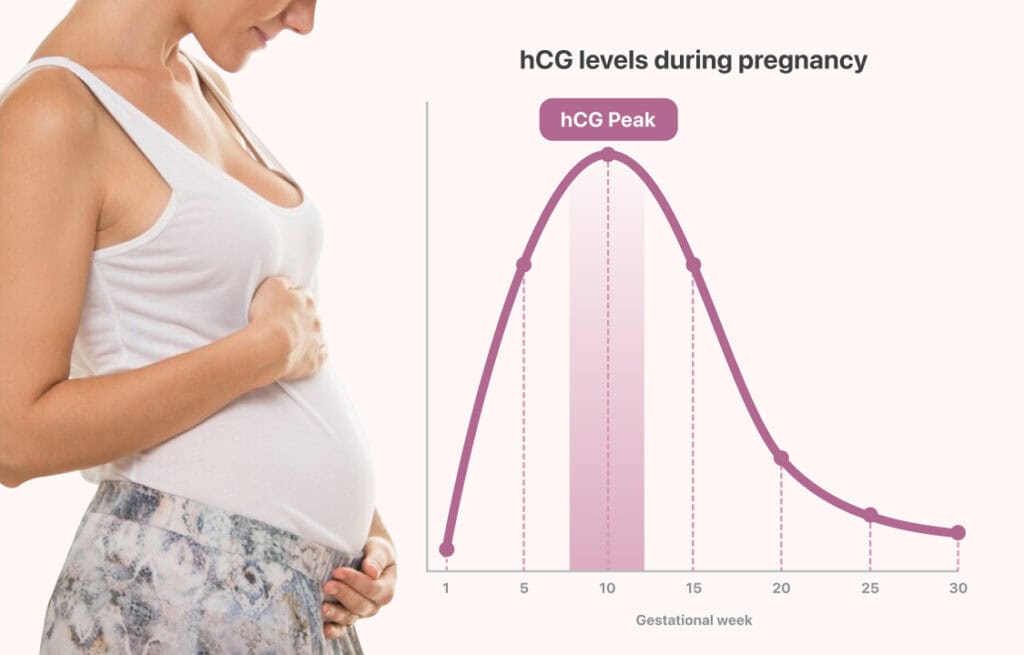
Explore this in-depth guide about the role of hCG in pregnancy, hCG levels by week, symptoms of rising hCG levels, and when to consult a doctor for an abnormality.
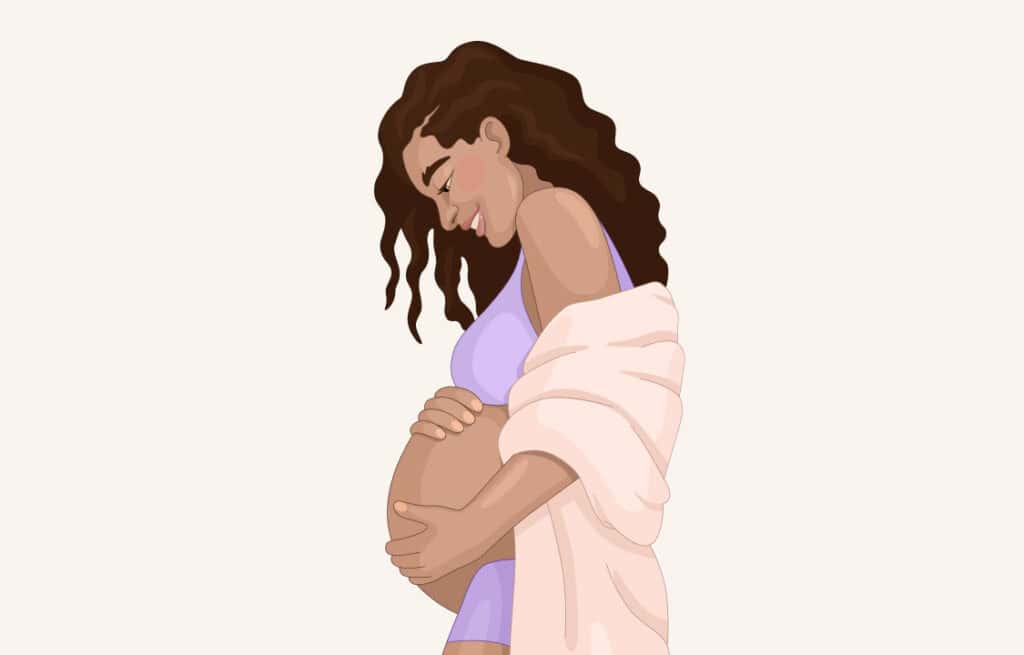
Discover what quickening is in pregnancy, when to expect it, and what it feels like. Learn how to monitor your baby’s first movements and when to consult your doctor about any concerns.
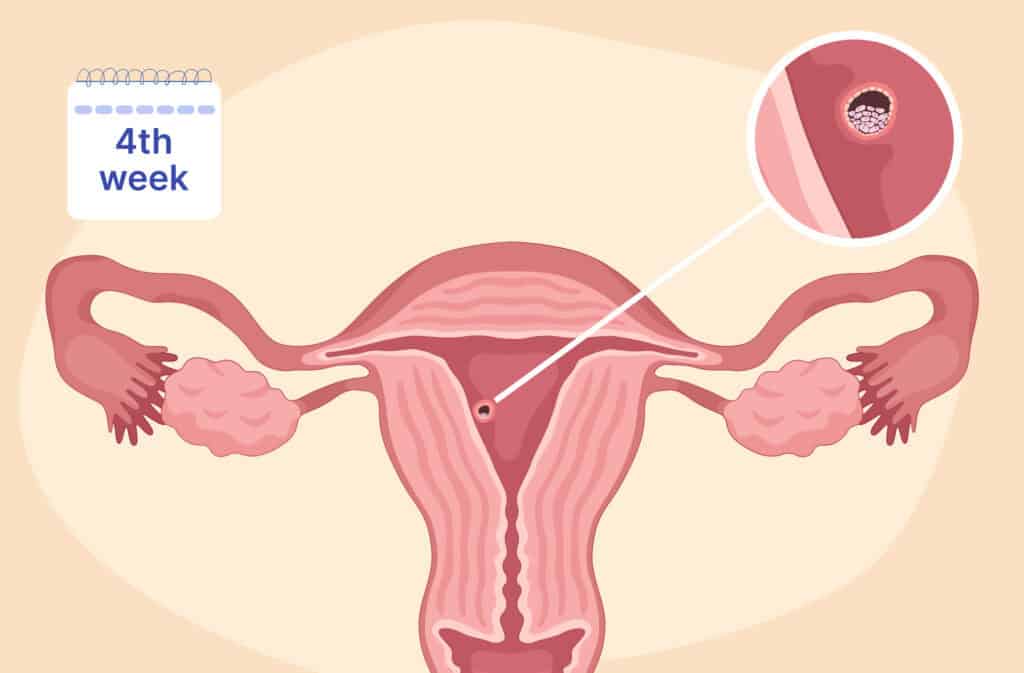
Learn about week 4 pregnancy symptoms, baby size, and the changes happening in your body as you progress in early pregnancy.

